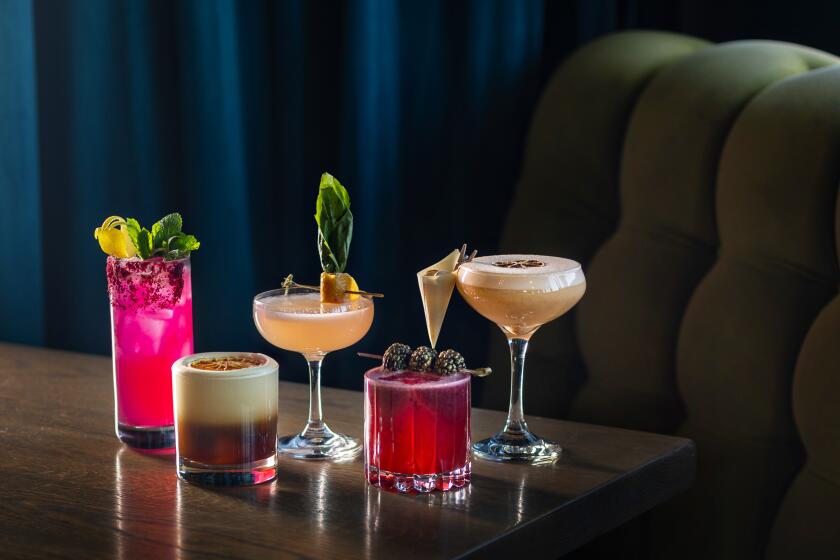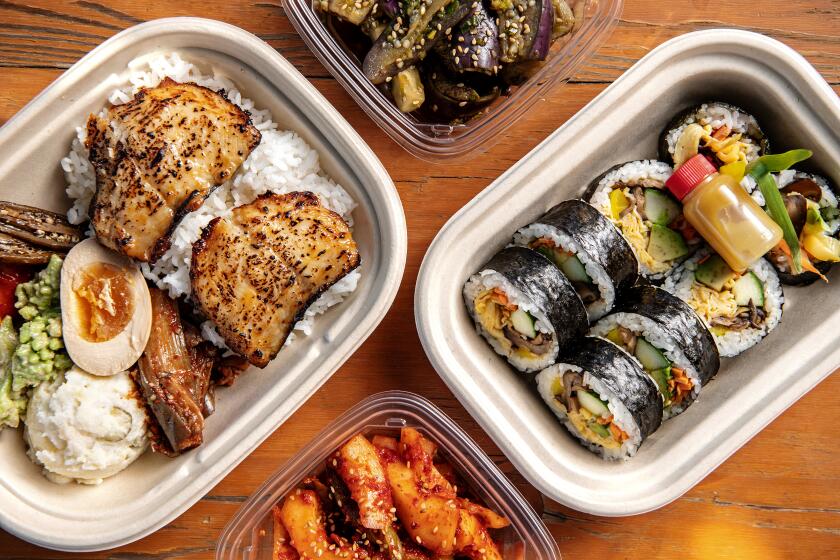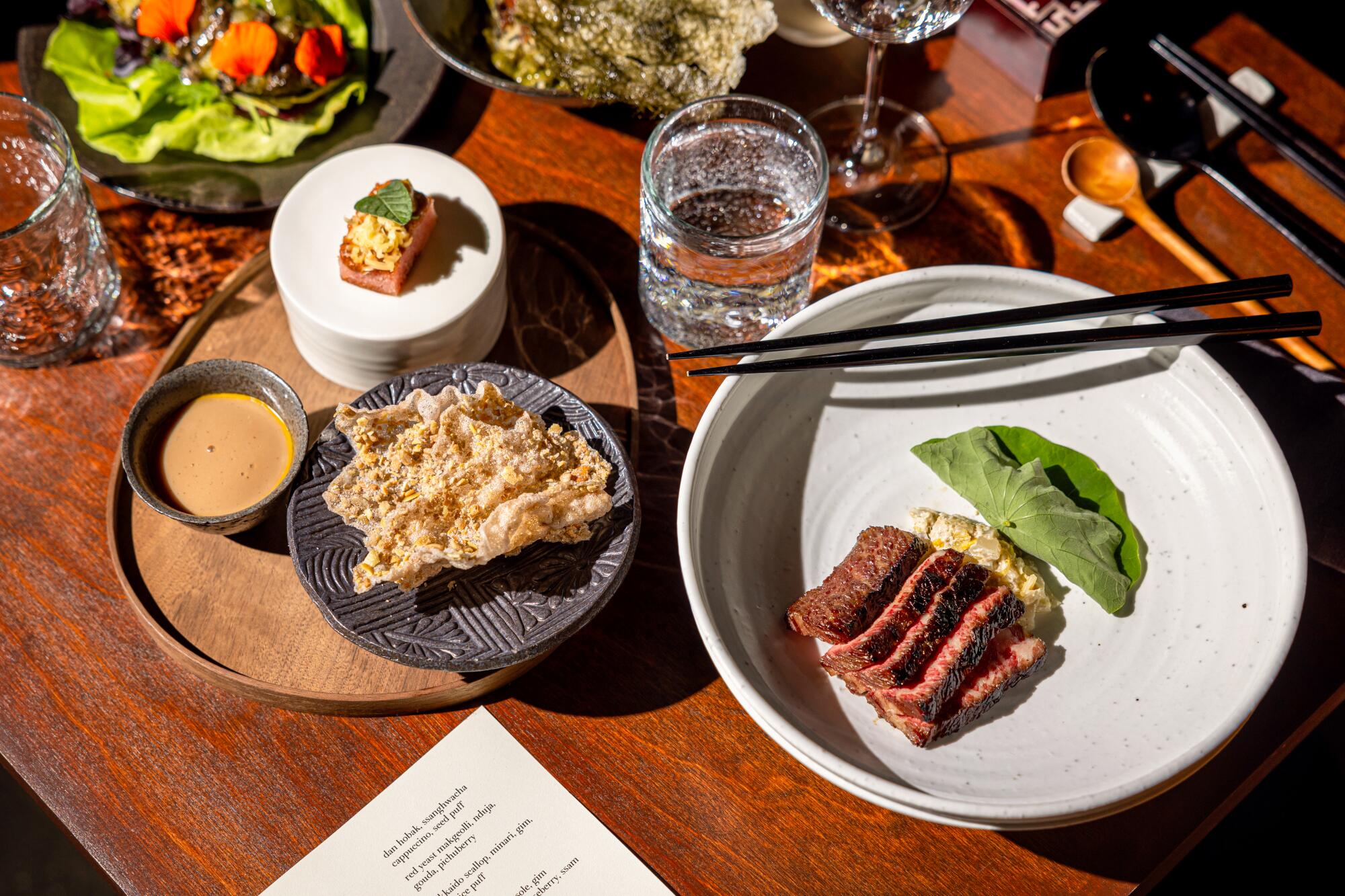
- Share via
If I had to choose one word to encapsulate the creative surge that propelled L.A.’s food culture forward last decade — a momentum that confirmed the city’s status as a global culinary destination, a spate of nonconformism that continues to influence how we think about restaurants — it would be Baroo.
The name might not register for everyone, so let me fast-forward to the present: Baroo, in its current incarnation, is a 4-month-old modern Korean restaurant in downtown’s Arts District. The kitchen prepares a succinct tasting menu, priced at $110 per person, the length and pace of which feels designed for Angelenos.
It doesn’t drag, but neither does it feel rushed. Seafood and meats arrive among fresh and preserved vegetables, lifted with fragrant sauces that can veer from subtle to intense and sweet to savory with each forkful.
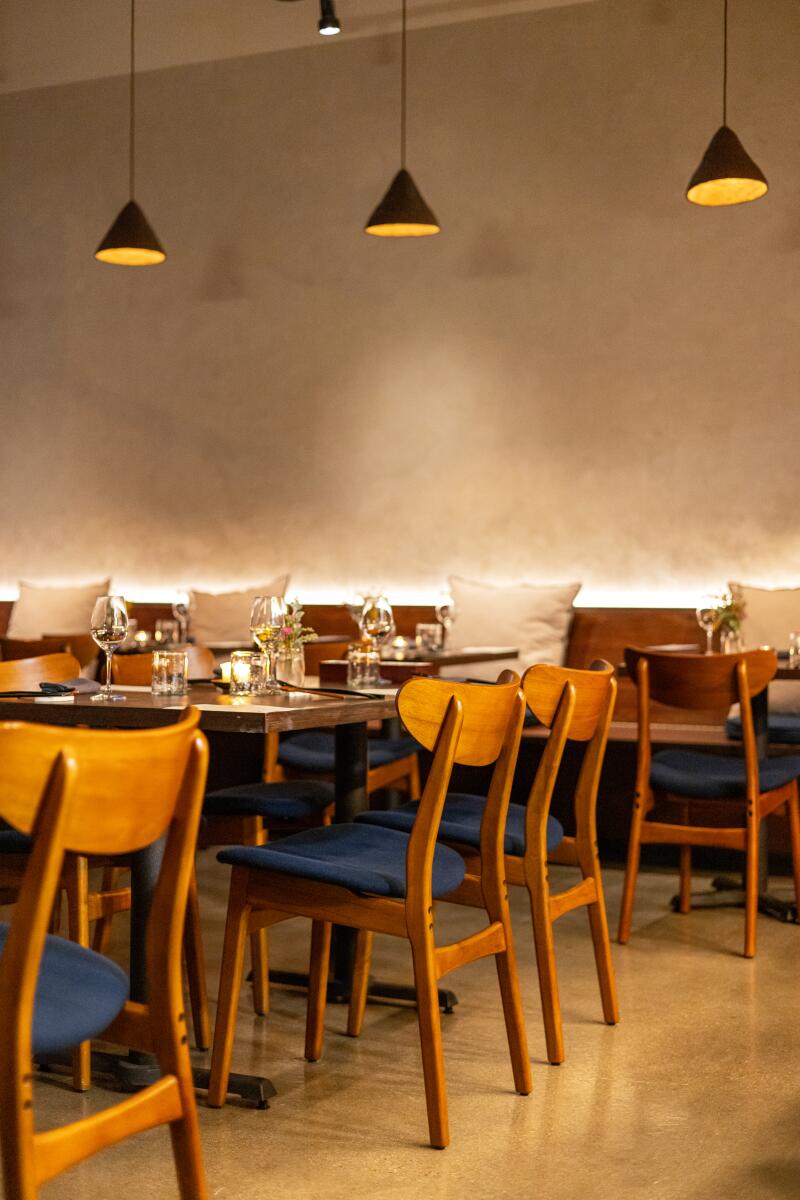
The modern interior of Baroo is roomy and comforting, with warm light surrounding the dining space.
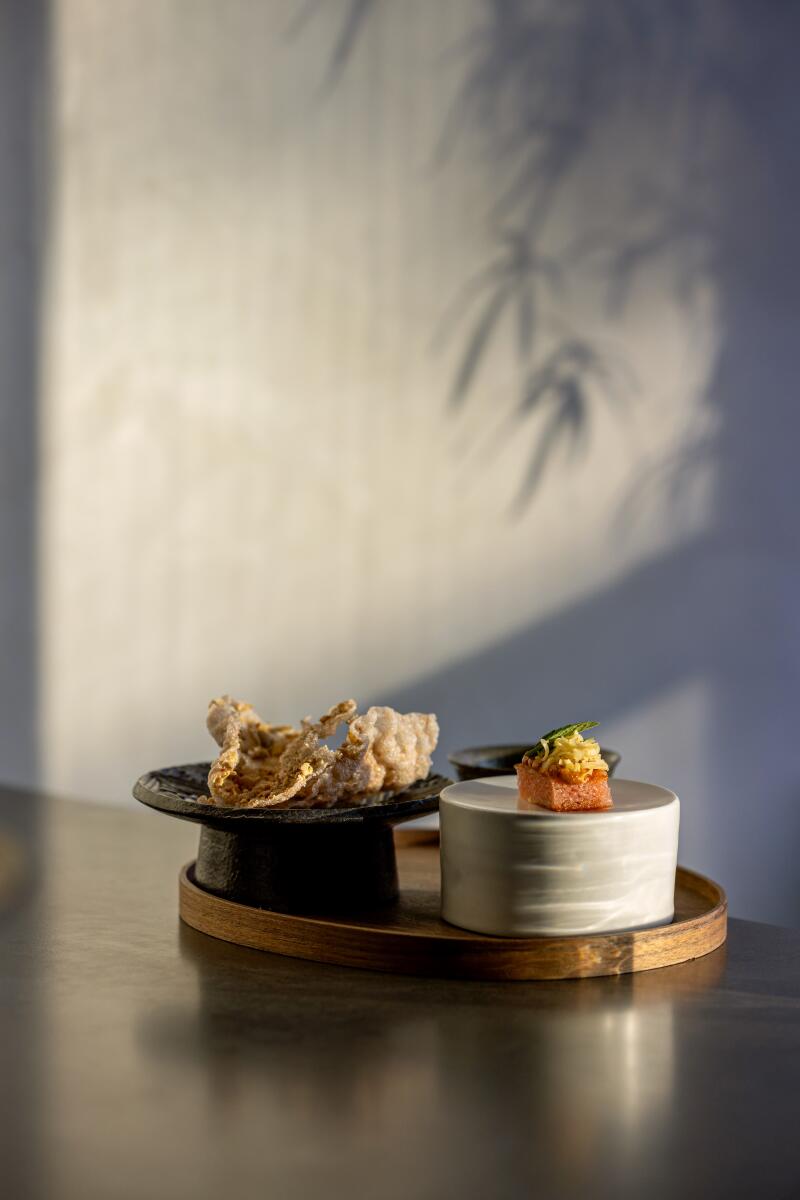
Baroo’s Tae, a course of dan hobak, ssanghwacha cappuccino, seed puff, and red yeast makgeolli with ndnja, gouda and pinkberry.
The room is comfortable and flatteringly lit. The service is gracious, staffed with the kind of people who notice you having trouble catching a song on Shazam and unobtrusively slip you the name of the Korean band written on a piece of paper.
It is, at face value, one of the most wonderful restaurants to open in the last year.
I know, though, that I am not alone in feeling like a Marvel character glitching and time-slipping whenever I walk through Baroo’s door: Part of me is settling into a seat at this new, handsome, efficient operation, and another is suddenly back at a cramped communal table in the bare-bones Hollywood strip mall where Baroo began in 2015. The original restaurant, unapologetically experimental and ephemeral, reshaped the way many of us thought about the places we go to be fed.
Kwang Uh grew up in Seoul and wound up wandering the planet in search of his culinary education. He graduated from the Culinary Institute of America in 2009, staged at global luminaries of the moment such as Noma in Copenhagen and Quique Dacosta in Spain, and logged stints at Daniel in New York and Nobu in the Bahamas. Matthew Kim, a friend Uh had made when they both studied hospitality in college in Korea, was living in Los Angeles, and the two decided to become business partners.
Sip on sake, craft beer, natural wines or agave spirits or try a soothing tea or uplifting coffee drink at one of our critic’s favorite places to drink in Los Angeles.
Uh directed all his fine-dining training into intricate grain bowls and pastas that cost $9 to $15. More significantly, he poured himself into these dishes. The kimchi and similar condiments that were an innate part of his family’s meals dovetailed with the era’s obsession with fermentation. The drink on hand at Baroo was kombucha, brewed by Uh in flavors including yuzu-lemon verbena and a potent elderberry. Jars of slowly transforming fruits and vegetables, labeled with blue kitchen tape, lined a shelf in the back of the space.
Not much else counted as decor, save for the massive blackboard on the wall listing the menu’s seven or so options and their many ingredients. There was also a framed quote that leaned on the restaurant’s counter. It began: “Where do these meals come from?”
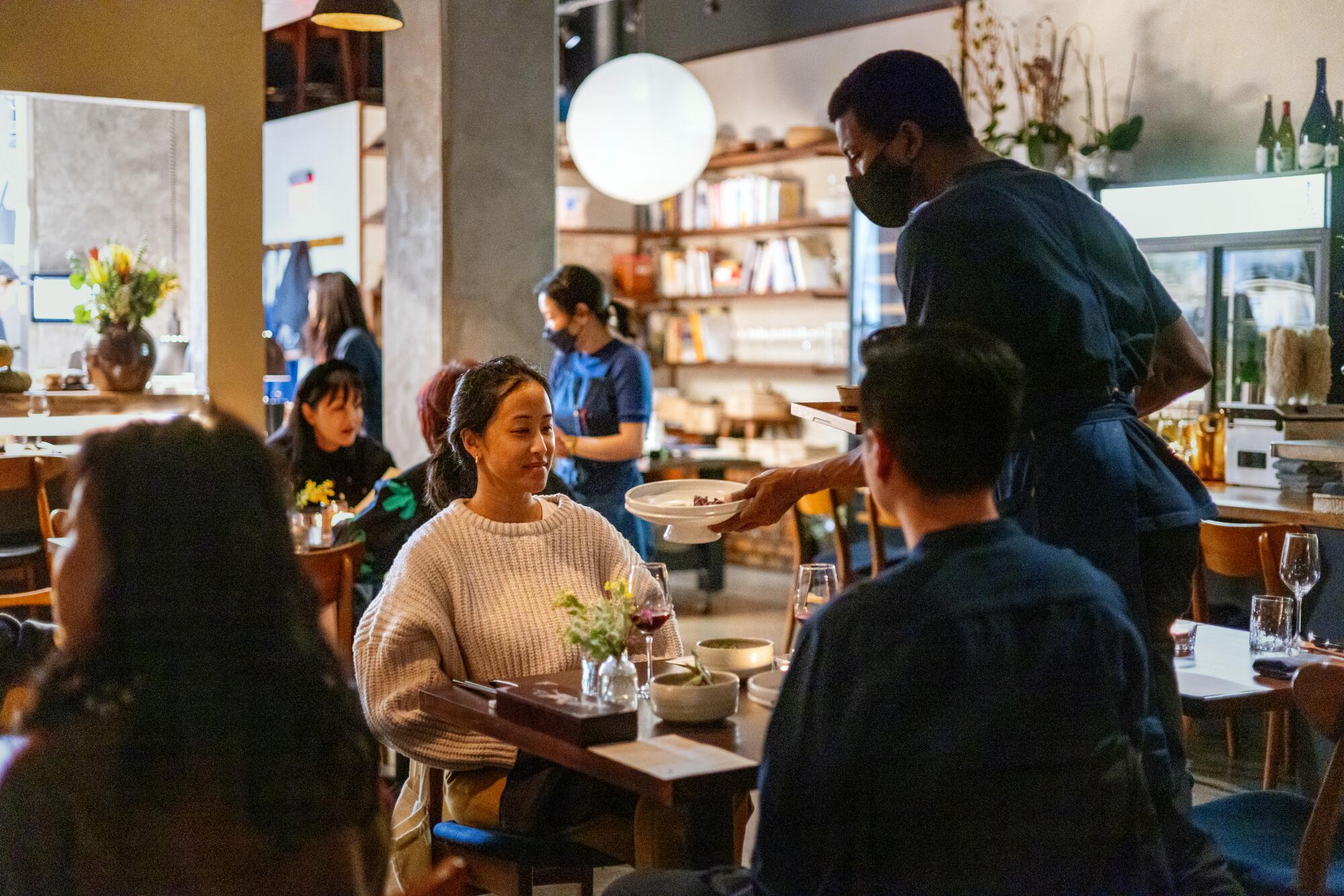
It was Uh’s rendition of a prayer he recalled from Buddhist ceremonial meals in Korea. He’d considered becoming a monk before he devoted his life to food, but something of his spiritual practice bled into his cooking and was like nothing I’ve encountered before or since.
The creation at Baroo 1.0 that L.A. food obsessives still mourn was called noorook, a phonetic spelling for the Korean counterpart to Japanese koji, the rice-based culture inoculated with the mold Aspergillus oryzae and used as a fermentation starter for miso, soy sauce and sake. Uh fashioned a version of noorook from spelt and buckwheat; he pureed it with roasted beets into which he folded a trio of grains, Job’s tears, kamut and farro, that had been simmered in dashi. Garnishes — microgreens, toasted sunflower and pumpkin seeds, chopped macadamia nuts, finger lime pulp, onion slivers pickled pink with rose — crunched and popped and bit back.
The textures were mulchy and chewy, even a little slippery. The flavors united with the easy, umami-thumping satisfaction of a Big Mac. It was a little otherworldly.
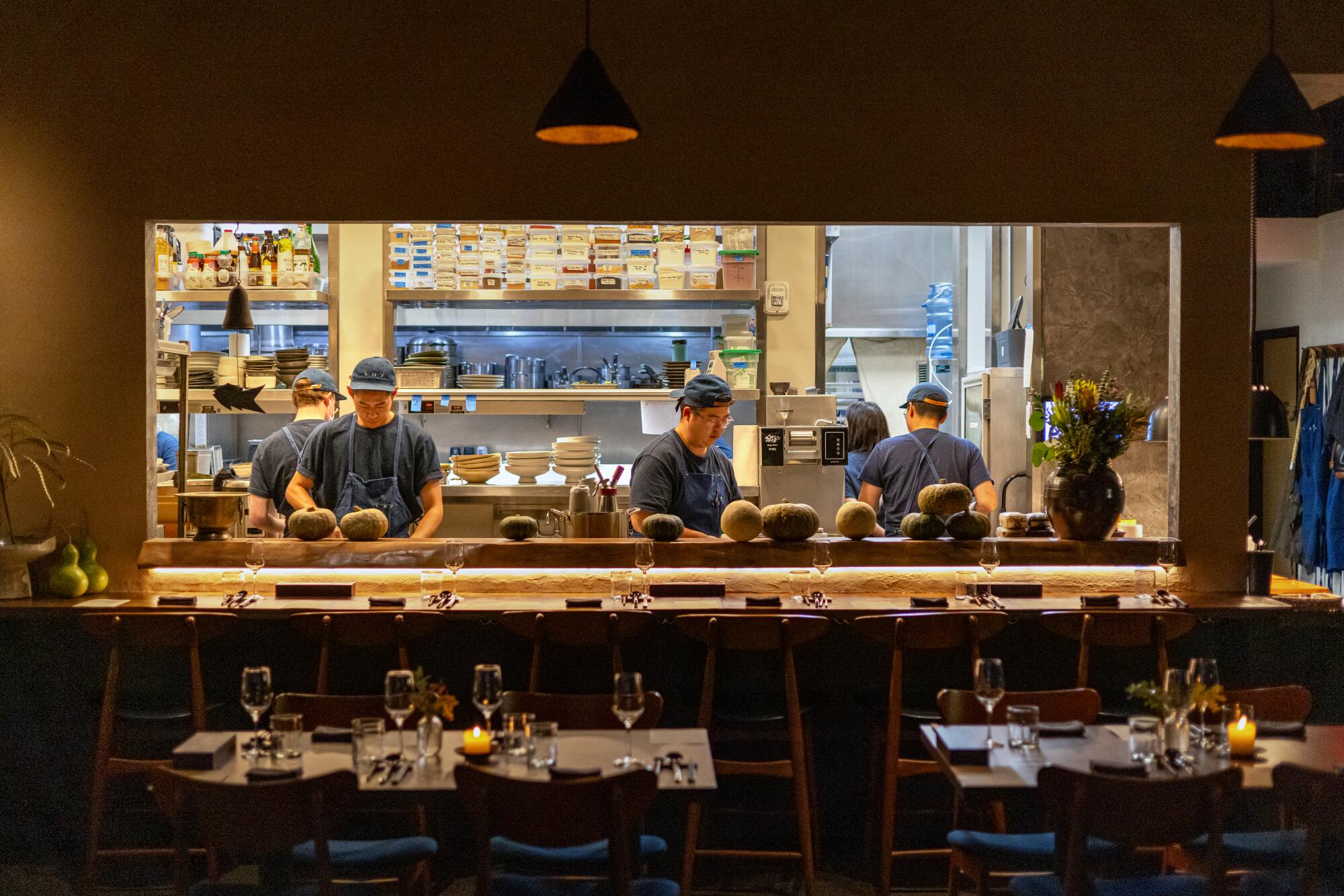
And the response for Uh and Kim must have been overwhelming. Local food writers went wild. National correspondents made pilgrimages. When the James Beard Foundation announced its 2016 semifinalist list for best new restaurants, Los Angeles scored two entrants: splashy, roaring Cassia in Santa Monica, a multimillion-dollar project deservedly showcasing the talents of Bryant Ng, and scrappy, tiny Baroo.
The restaurant embodied so many of the qualities that give Los Angeles its character. It was cooking as personal narrative, with an approach to seasonal freshness that incorporated notions of preservation and transformation. Uh’s pineapple-laced kimchi fried rice and brainstorms like oxtail ragout with gochujang and sauerkraut powder bridged the arc between Roy Choi’s Korean tacos and Ludo Lefebvre’s layered, unbridled tasting-menu courses at Trois Mec.
Baroo could be chaotic. Long waits, items frequently running out. At the beginning of its run it was only Uh and Kim. Hiring staff meant they couldn’t afford to pay themselves. Uh burned out from his solo hours at the stove. On a summer sabbatical from the restaurant at a South Korean Buddhist temple, Uh met Mina Park. They would eventually marry and join forces in business.
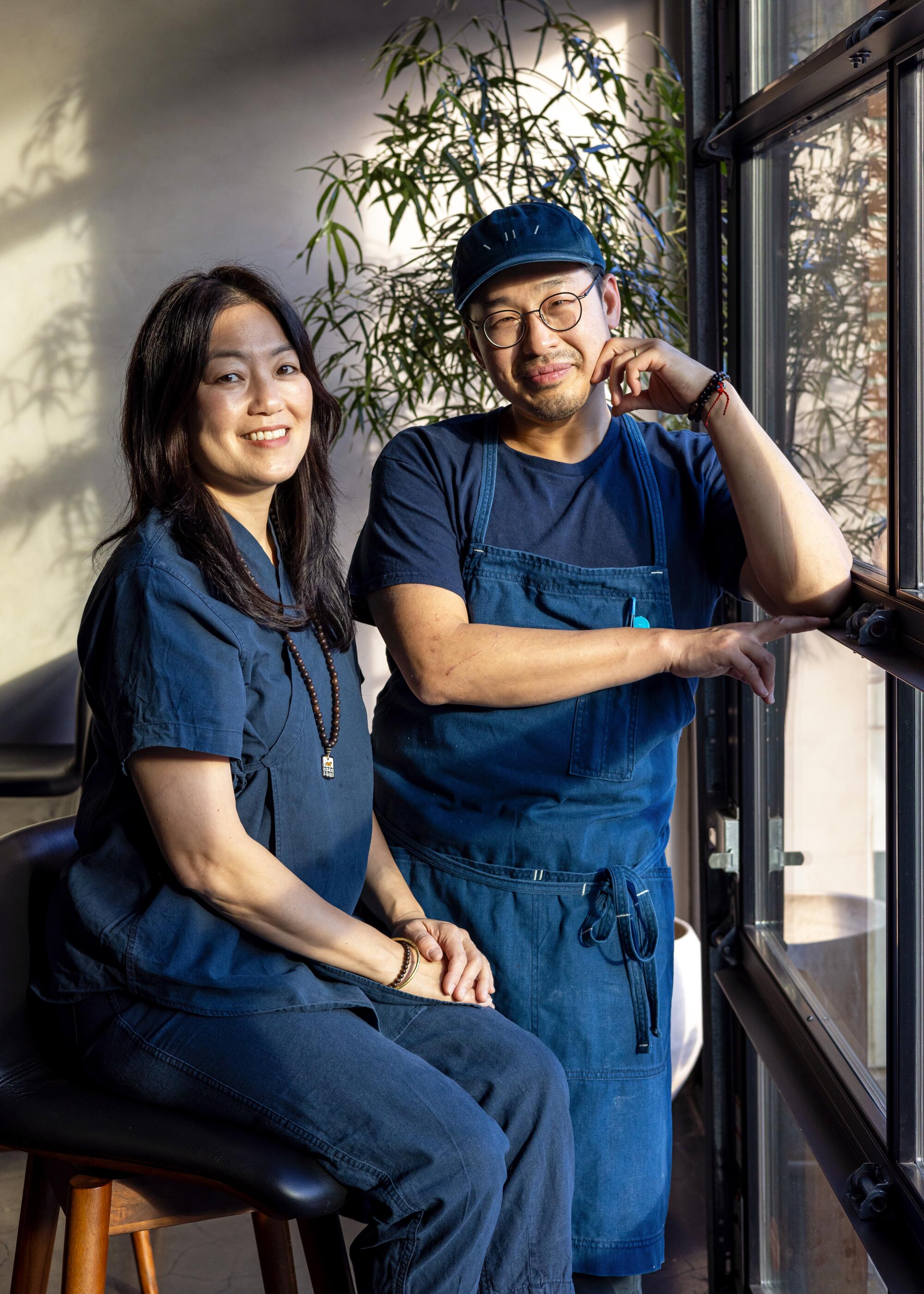
After a series of unexpected closures, followed by just-as-sudden reopenings, the original Baroo fell silent for good in October 2018. Its short, spectacular existence reinforced the truth that excellence can be temporary and unsustainable without being labeled a failure. It may have even helped prepare us for the pandemic, during which chefs turned to selling food cooked with formidable skills and broken hearts in their home kitchens.
In 2019 Uh and Park had a short-lived stall inside East Hollywood’s Union Swapmeet they called Baroo Canteen, serving pared-down versions of Uh’s grain bowls. In 2021 the couple opened Shiku (Korean for “family”) inside Grand Central Market. Among its practical menu of bibimbap and kimchi-braised pork belly or galbi bundled with rice and banchan, I would look for traces of the old alchemy. Mostly I knew I had to wait for Baroo’s reincarnation, in whatever form it might take.
Uh and Park unveiled their reimagining in the Arts District in September.
Baroo 2.0’s tasting menu comprises about eight dishes served in six courses. The dishes have been themed around a Buddhist view of the human life cycle, from prebirth to after death, though they seem to serve more for Uh’s internal inspiration than any literal translation with which diners need concern themselves.
This tiny, mighty banchan shop in L.A. argues that the small dishes served alongside rice in Korean restaurants can be the star of the meal itself. Perilla is the city’s vital new lunchtime destination.
The core composition of the meal has been the same since opening, though the kitchen quietly swaps out ingredients as the growing seasons revolve. Currently dinner begins with a frothy cup of maple-sweet pumpkin soup; Uh brings it out alongside a thick square of rice bread with a homey chew that’s covered in shaved Gouda and pureed ’nduja with a sliver of gooseberry. A seared Hokkaido scallop in a tiny bowl appears next, topped with squiggles of puffed rice and steeping in emerald-colored seaweed broth with a flavor more herbal than oceanic. These are gentle enticements into Uh’s culinary worldview.
Then: aha. At the first soft crunch of the next dish, a fish ssam, the lights all come on, and stay on for the duration of the savory courses. Here is the essence of the uncanny genius I remember.
Lightly brined skate wing is fried in a batter of three flours, vodka and seaweed, sometimes augmented with spinach for brightness. The appearance resembles a similar recipe from China’s river-laced Jiangnan region (I’ve long admired the version at Jiang Nan Spring in Alhambra), but the ultimate effect, by design, recalls fish and chips and the specific crackle of Korean fried chicken. A butter lettuce leaf wrap cradles the fish with fresh herbs and hidden slicks of gooseberry emulsion and seaweed remoulade. The flavors sway between earth and sea, with occasional, mysterious jolts of vinegar and umami.
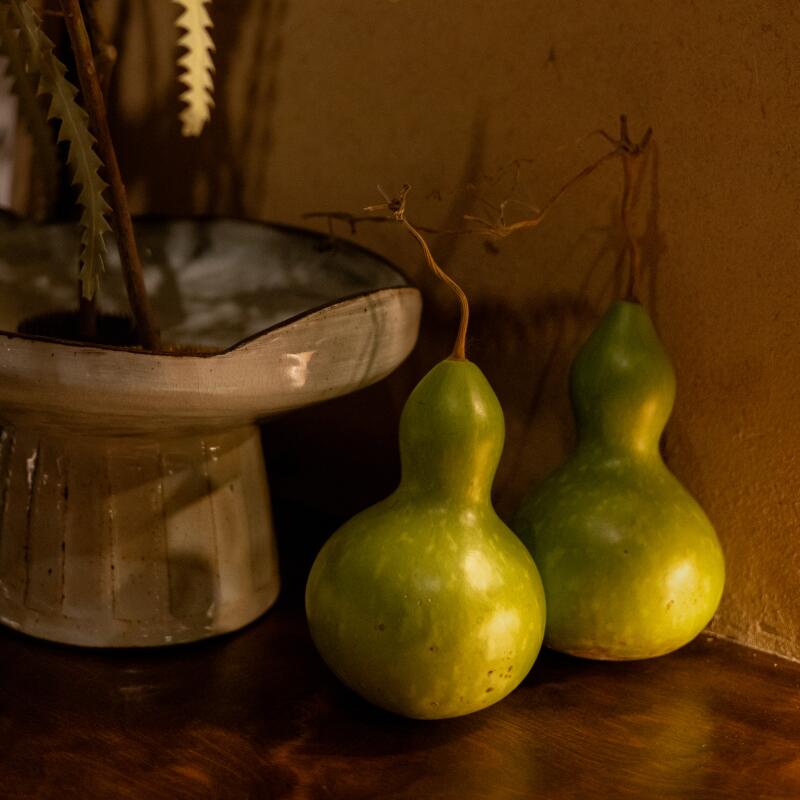
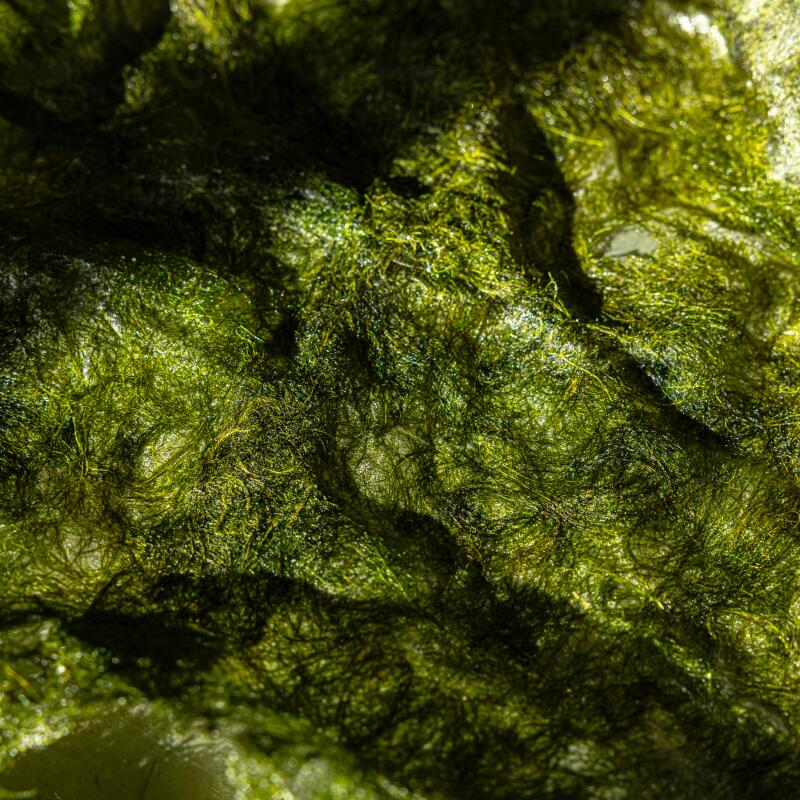
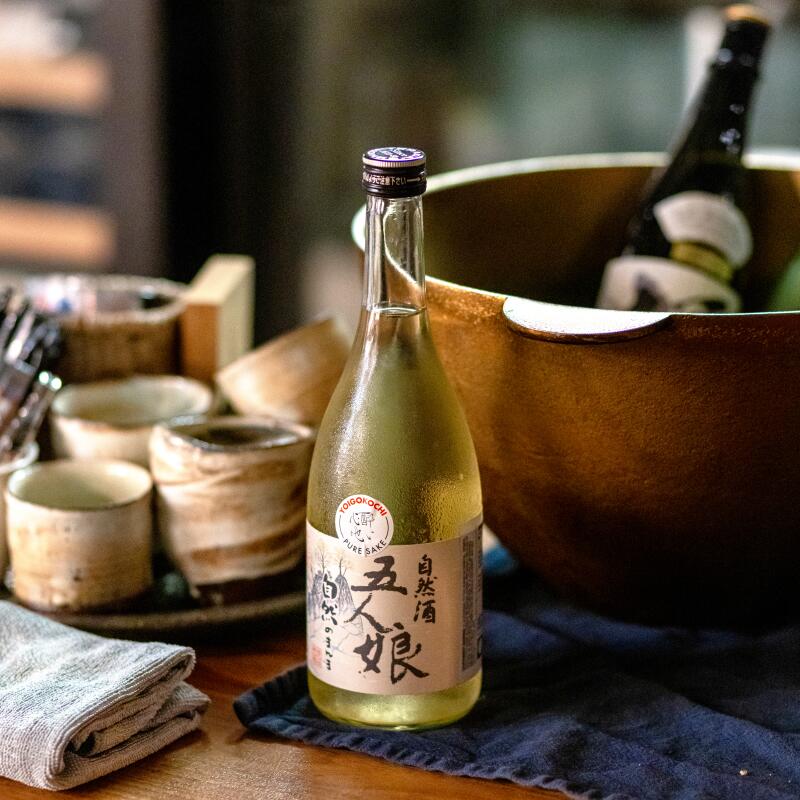
Shades of green inside the restaurant give verdant tones to the surroundings, whether through decorative pears, a kelp sheets drying in the late afternoon sun, or cold bottles of sake at Baroo.
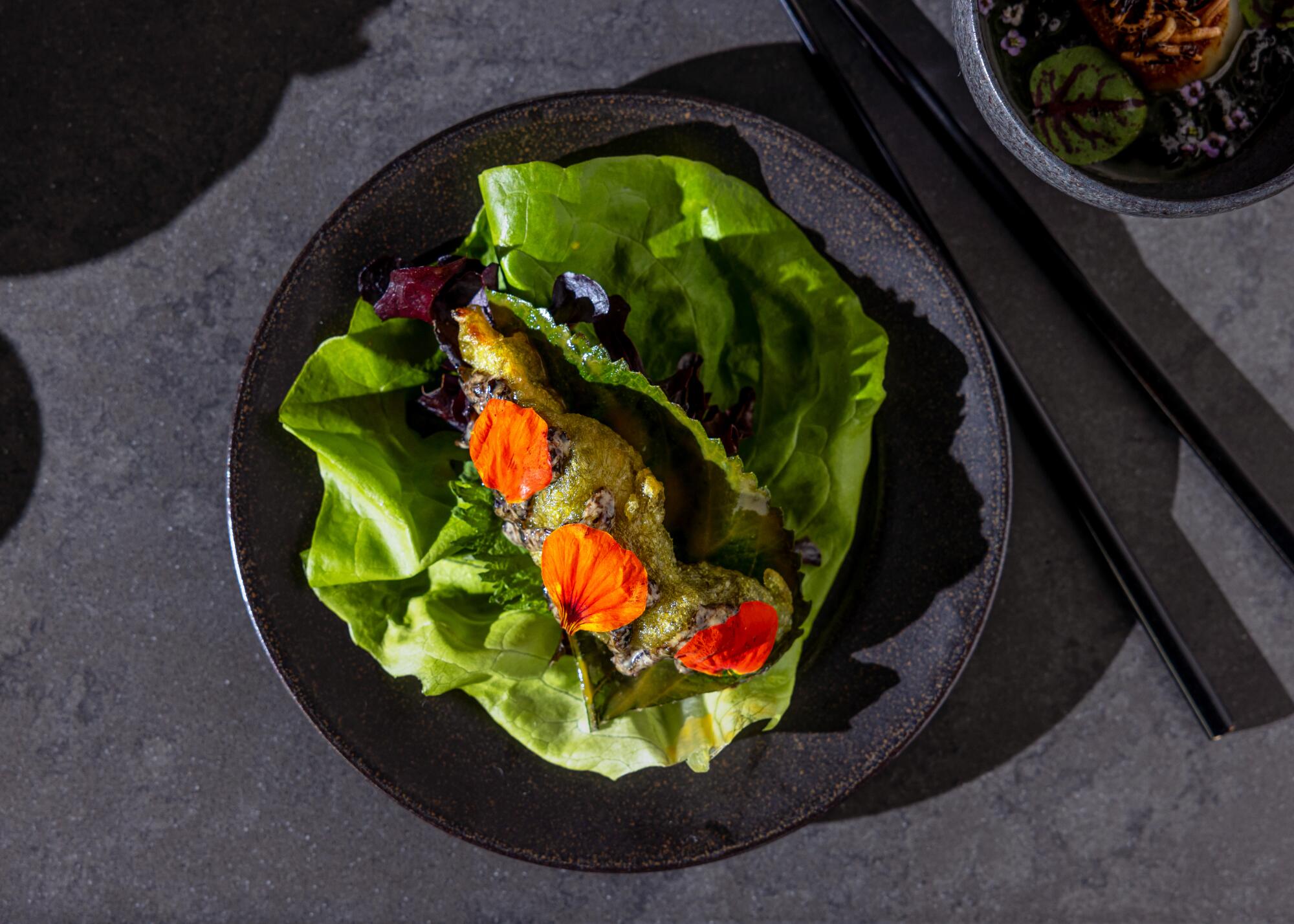
This is how the best of Uh’s dishes unfold, like riddles. Presentations are as beautiful and orderly as topiary, and often adorned with shatteringly thin chips for texture, but only the palate can divine the unseen depths. Finely tuned sauces gloss most plates. If you quiz Uh about them, he’ll slip in mentions of Korean building blocks — gochujang (red chile paste), doenjang (soy bean paste), ssamjang (a dipping sauce that usually includes gochujang and doenjang) — but there are also less perceptible herbs and spices filling in the tight harmonies.
Maybe the only falter is dessert, a creamy-icy concoction that includes melon panna cotta and fresh sorrel bingsu. The combination ties a ribbon on the evening’s earthy themes but comes off more as last decade’s New Nordic movement and less as Baroo’s right-now ascension. I’m sure there’s a sweet ending in Uh’s imagination that more closely expresses his evolution.
Across the board, beverage director Jason Lee does a masterful job of complementing Uh’s cuisine. He honors the restaurant’s origins with a nonalcoholic pairing anchored by kombuchas — a minty, earthy barley-shiso variation, say, mixed with a sweet potato distillation and NA white wine to pair with soy-braised black cod. His wine list is succinct and smartly curated, but he’s also hoping diners trust him to explore the universe of food-friendly Korean spirits. I’d suggest a glass of Yangchon chungju, a refined rice wine that brings to mind sake with mushroom notes.
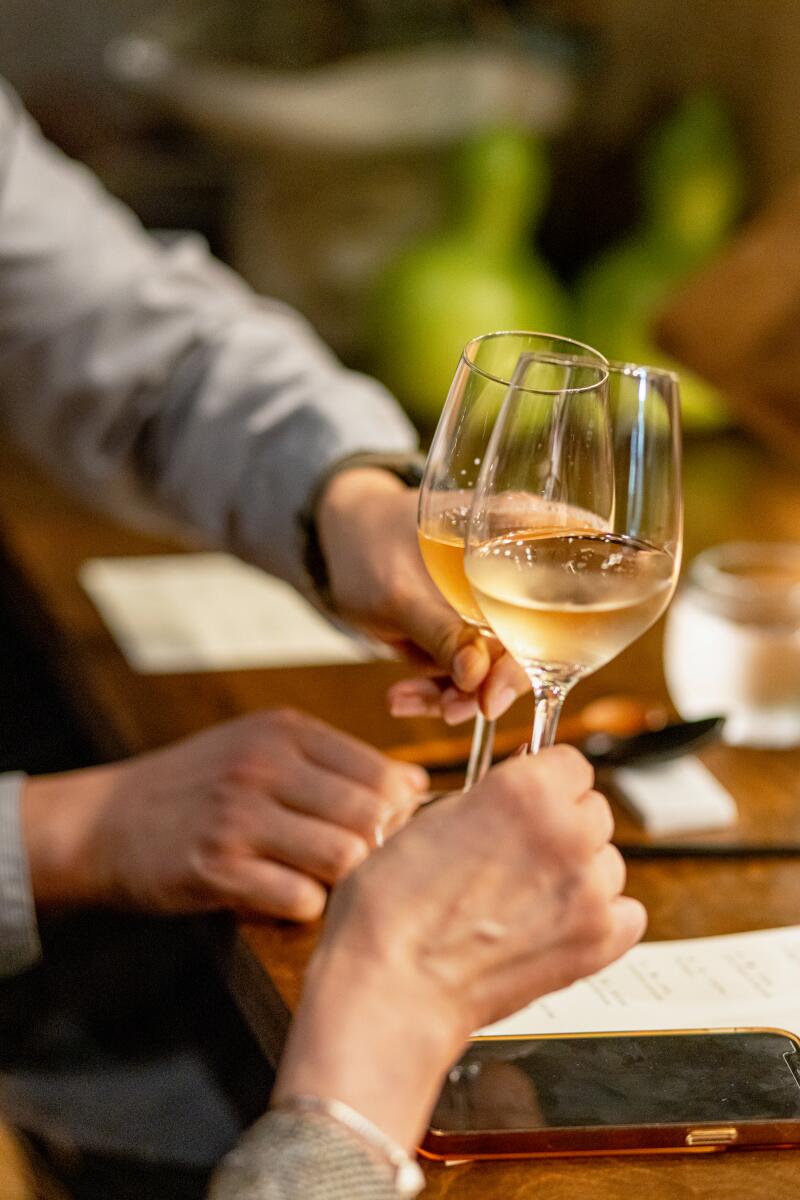
Wine glasses clink at the open bar. The new Baroo now has a full beverage program.
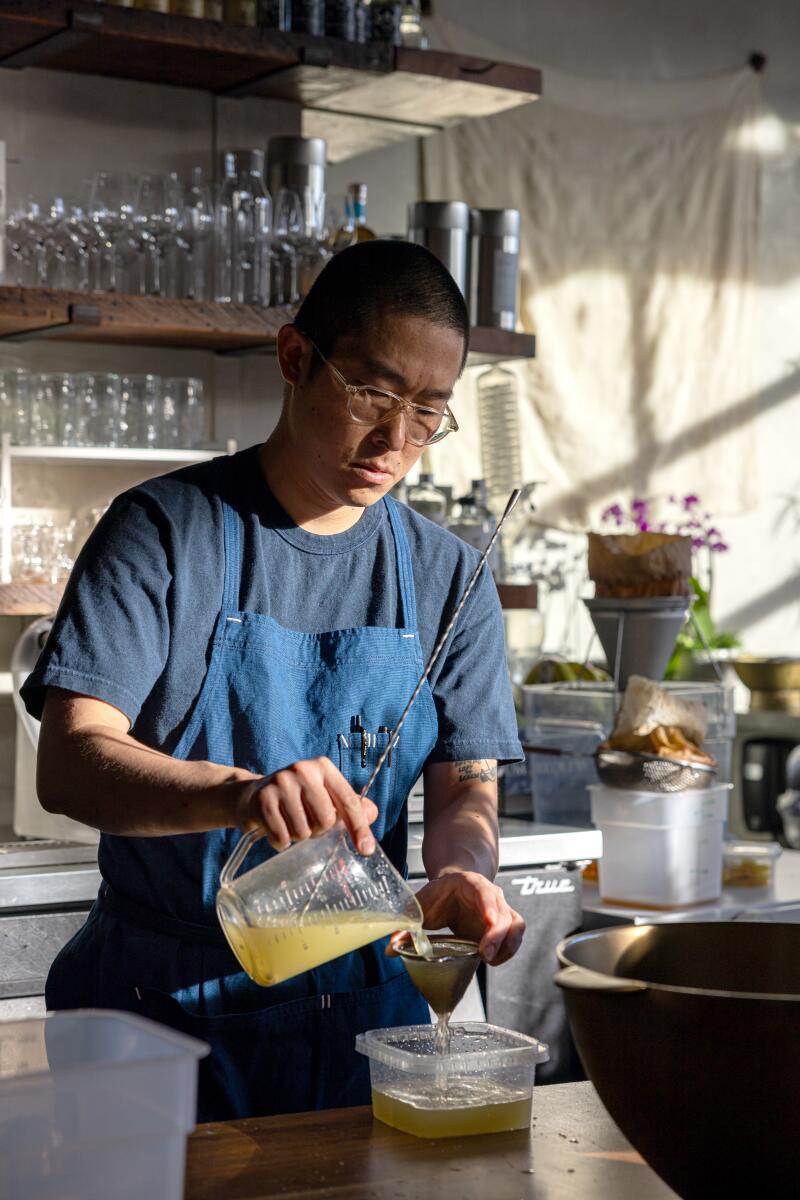
Baroo beverage director Jason Lee prepares one of his non-alcoholic kombucha drinks.
It is still startling to this longtime observer that Baroo now has a full beverage program, and a stylish dining room, and a kitchen staff to support Uh. Is the food the same brain-jangling thrill ride as the original? No. Is it an expression of a maturing chef who now has a family, who is embracing structures to sustain a business, whose more nuanced flavors require you to pay closer attention? Very much so, and the results are powerfully rewarding.
Nothing is ever guaranteed — impermanence is Buddhism 101 — but I think we can worry less about this iteration of Baroo vanishing suddenly. What a godsend for Uh’s many fans, and for Los Angeles.
Baroo
905 E. 2nd St., Los Angeles, (213) 221-7967, baroolosangeles.com
Price: Tasting menu, built around Kwang Uh’s singular modern Korean cuisine, at $110 per person.
Details: 5-11:30 p.m. Tuesday-Saturday. Wine, cocktails, an enthralling list of Korean spirits and an equally compelling nonalcoholic beverage pairing. Street and lot parking.
More to Read
Eat your way across L.A.
Get our weekly Tasting Notes newsletter for reviews, news and more.
You may occasionally receive promotional content from the Los Angeles Times.
